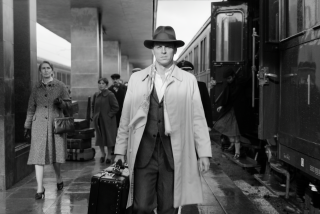TWO VIEWS OF THE UNDERCLASS : Dry-Ice Lust Establishes Theme for This Darkly Obsessive ‘Dance With a Stranger’
- Share via
The heat and hunger of an obsessive love affair are the background for “Dance With a Stranger” (Beverly Cineplex and Cineplex Odeon Brentwood), a ripe, dark new British film. For anyone with even a passing knowledge of love as pain, it is like a body blow.
The dry-ice lust between Ruth Ellis (Miranda Richardson), white-blond hostess of a London “private club” with rooms available upstairs, and David Blakely (Rupert Everett), a sulky, pretty toff who barges into her life late one night in 1954, isn’t conjecture. Shelagh Delaney (“A Taste of Honey,” “Charlie Bubbles”) based her cruelly illuminating screenplay on careful research into the actual case, since the love affair grew into a crime of passion with lasting reverberations throughout England.
Third member of the lethal triangle is lifelong bachelor Des Cussan (Ian Holm), a good sort, dangerously self-effacing and obviously infatuated with Ruth. Delaney and director Mike Newell are very, very good at keeping us a little off balance as to which of these three will be pushed into violence--it’s an almost palpable part of the three intertwined lives. The film seems to embody the morality of the 1950s, decadent and queasy underneath but kept under a tight, brightly untruthful lid.
Ruth Ellis looks like a compendium of the runners-up in a Marilyn Monroe look-alike contest and everyone calls her “Mrs. Ellis.” It suits her; in another era she might have been a king’s mistress, a backstage tart with access to the royal bedchamber. England has had improper missises for centuries--their only harm is when they somehow lose their sense of place.
It isn’t Mrs. Ellis’ fault that she forgets hers. As their affair mounts, Blakely--alternately dependent and aloof--muddies their situation with desperate sentences like, “I shan’t have any rest until we’re married.”
Kept promises, broken ones, bouts of frantic love-making and physical brutality in public: With this behavior, Blakely undermines Mrs. Ellis’ innate and shrewd common sense about class, position and men. He even takes her outside London to show her his mother and stepfather’s estate, then squirms out of introducing her when he sees his parents in the quaint country village. Their affair becomes a round of attraction/abasement that neither of them can break.
You don’t have to have been a British bar hostess to have gone through this kind of torture. The power of “Dance With a Stranger” is its ability to hit a private nerve; you may find yourself matching Ruth Ellis’ emotions with your own as the memory of every cheek-flaming humiliation you’ve ever suffered floods back involuntarily.
Throughout, the stolid Des is at her side, worrying about Mrs. Ellis’ 10-year-old son, taking them on a seaside holiday, underwriting the boy’s education at a decent prep school. Des remains savage, however, in his dislike for Blakely, whom he originally brought round to the club.
Richardson’s grasp of the character is triumphant. She tells us everything about Mrs. Ellis: her desperation for “niceness,” her hatred of sex (turned around by something Blakely unlocks in her), her alternating patterns of tender and shamefully neglectful mothering. Holding her rhinestoned harlequin glasses to her eyes to peer nearsightedly up at a client (“Men never make passes . . ., “ she says archly), she is vain, mysterious and deeply touching on an almost unfathomable level. It seems impossible that the film, which won the best foreign film award at Cannes this year, is theater-trained Richardson’s first.
Rupert Everett and Ian Holm are better than perfect foils for her. Holm makes Des’ loyalty suitably pathologic. Everett is the incarnation of the spoiled aristo, on his uppers in bespoke tailoring. Looks and breeding and arrogance have brought him a long way, no need to disturb the balance by adding compassion or particularly complicated thought processes at this point.
Although Everett is better at Blakely’s sulking and self-absorption than at a sense of wracking passion, his looks will still carry him a while, too.
The technical side of “Dance With a Stranger” is impeccable, in particular Peter Hannan’s brooding cinematography, the absolute rightness of Andrew Mollo’s production design, Richard Harley’s evocative music (if you can stand hearing “How Much Is That Doggie in the Window” done straight) and Pip Newbery’s costumes, which bring back the ‘50s in all their strapless, crinolined horror.
More to Read
Only good movies
Get the Indie Focus newsletter, Mark Olsen's weekly guide to the world of cinema.
You may occasionally receive promotional content from the Los Angeles Times.










